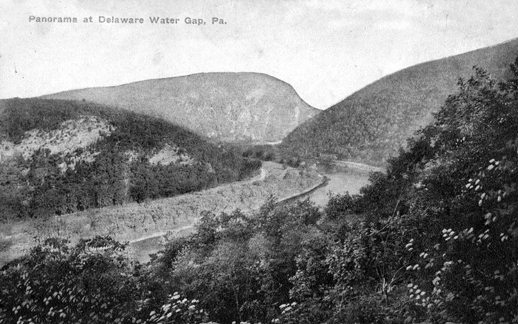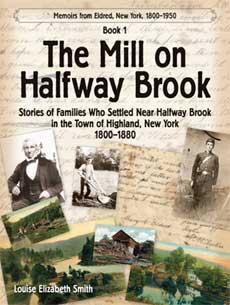The Delaware River Gap was a large break in the Appalachian Mountains. It was one of the very scenic places viewed by timber rafters as they floated their rafts to market on the Delaware River. Postcard of Aida Austin.
The Delaware River near Narrowsburg, New York, had originally been so narrow and with such a sharp bend, that there was barely enough room for a raft to pass through its sharp, rocky shoreline. By 1872, the Narrowsburg passage had been made wider and deeper and other places along the Delaware River had been made easier to navigate in the event of a low water freshet.
Even with improvements, timber rafting was still quite challenging in 1872. That didn’t stop men who were sixty and as old as eighty from helping raft lumber to market when the Spring freshet came.
Both single and double rafts were guided down the Delaware River to Trenton, New Jersey, where they were towed to markets in Philadelphia, Pennsylvania. A single raft of sawed lumber contained about 75,000 board feet and required two or three men to steer it.
A double raft was 25 feet by 75 feet and contained up to 150,000 board feet. Four men, two at each end, each with an oar, guided and steered the double raft clear of obstacles. The oar was an 8-foot long hemlock blade securely fastened to “a long chestnut or ash handle, made of a sapling, five or six inches in diameter at the blade end, and tapering down to a point.”
The most responsible position on the raft was that of the pilot or steersman who gave directions from the left hand side of the rear end of the raft. The steersman shouted out—Jersey, Pennsylvania, or New York—to tell the others which state shoreline to pull the raft to as they navigated down the Delaware.
The Delaware River raft ride in an early Summer freshet flowed through ”wooded mountains, extended fertile plains, high, rock-bound shores, gentle slopes, shady groves, tidy farmhouses, and luxuriant farms.”
Some of the “grandest scenery, viewed from a raft” could be seen in the vicinity of the Delaware Water Gap—a large break in the Appalachian Mountains, about 40 miles south of Port Jervis, New York, and four miles southwest of E. Stroudsburg, Pennsylvania.
“For miles and miles the river can be seen winding through the valley—on one side mountains rising abruptly from the water’s edge, and on the other green fields and receding hills. Far off to the north the lofty summit of the old Poemo Mountain can be seen, over which the busy trains of the Delaware and Lackawanna Railroad toil and steam continually. In a clear, still day the silver threads of smoke from locomotives can be plainly seen rising toward the sky. In every direction hazy hills rise and extend along the scene until lost in the purple, hazy distance.”
In 1872, close to 200,000,000 feet of lumber was exported from the Upper Delaware River region by way of rafting down the Delaware River; the Delaware and Hudson Canal; or the Erie, and Delaware and Lackawanna Railroads. There were hundreds of mills which could produce 500,000 to 1,000,000 board feet a year.
Source: The Lumber Trade: History of the business in New York and Pennsylvania; Where Timber and Lumber Come From—Story of a Raft—Location of the Saw-Mills and Statistics of the Trade. The article was written in Narrowsburg, N.Y., Thursday May 9, 1872, and published May 11, 1872, in The New York Times.









My Great Grandfather Lewis Hawley and Grandfather Warner Hawley were both Raftsmen on the Delaware and farmers and Timber harvesters living at Downsville, Delaware Delaware County. I have the book “Holt Tother Way” Which contains many stories 0f the men who rafted the Delaware in those long gone days. I would be most pleased to receive any other info and stories that may be out there.
In our family lore the raft were built on the ice and chained to the shore. A small log cabin was built on the raft got the women and children.
Stacks of hand quarried blue stone were also secured and all manner of hand crafts were stored. When “the ice went out” the raft was cut lose and off they went.
The farm is still in the family in the Long Eddy section of Delaware county. The last man to actively farm the ground was Silas Thompkins, my wife’s step great grandfather. He died in 1972 at the age of 98. A true privilege to have known him, he was a living history book. Great stories.